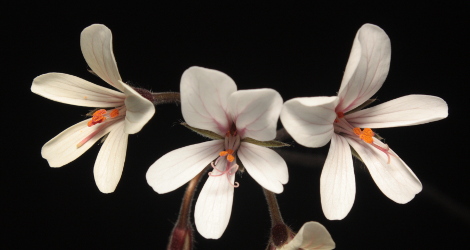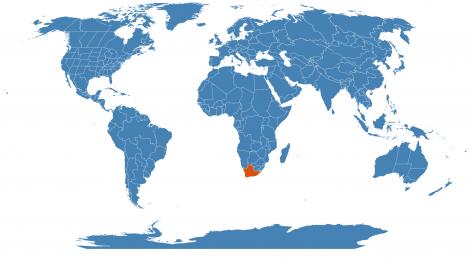Accession Data:
Pelargonium barklyi Scott-Elliot
subg. Paucisignata sect. Ciconium
- Common Name:
- Family: Geraniaceae Juss.
- Description: Pelargonium barklyi is a native of western coastal areas of South Africa. The tubers are fairly large and round. A stemless rosette of leaves is formed at the soil surface. Leaves are very distinct, being round, and having depressed veins radiating out from the base. The depressed areas are a darker color than the rest of the leaf. Flower stems are very long, up to 65 cm. (2 feet), and are topped vath five to seven, or more, flowers that are pure white or white with slight pink veins at the base.
- Culture: This is one species that does best in a large container. It just cannot produce a largd enough tuber in a small pot to survive the summer dormancy in really warm climates. If grown in a small container, it will survive dormancy better if stored away from really warm areas. This beautiful plant is easily grown from seed.
Accession Data:
- Accession # 200700001
- Source: Dylan Hannon, Huntington Botanical Gardens
- Provenance: J. Lavranos s.n., Garies, Western Cape, Huntington Botanical Gardens #93228
- Accession Date: 02-02-2007
- Bench: 0 - unassigned location
- Currently: deceased
- Qty: 0 confirmed on 12-05-2018
Classification:
- Division: Magnoliophyta
- Class: Magnoliopsida
- SubClass: rosids
- Order: Geraniales
- SubOrder:
- Family: Geraniaceae
- SubFamily:
- Tribe:
- SubTribe:
Flowering Data:
This accession has been observed in bloom on:| Year | Jan | Feb | Mar | Apr | May | Jun | Jul | Aug | Sep | Oct | Nov | Dec | ||||||||||||||||||||||||||||||||||||||||
|---|---|---|---|---|---|---|---|---|---|---|---|---|---|---|---|---|---|---|---|---|---|---|---|---|---|---|---|---|---|---|---|---|---|---|---|---|---|---|---|---|---|---|---|---|---|---|---|---|---|---|---|---|
| 2018 | ||||||||||||||||||||||||||||||||||||||||||||||||||||
| 2017 | ||||||||||||||||||||||||||||||||||||||||||||||||||||
| 2016 | ||||||||||||||||||||||||||||||||||||||||||||||||||||
| 2015 | ||||||||||||||||||||||||||||||||||||||||||||||||||||
| 2014 | ||||||||||||||||||||||||||||||||||||||||||||||||||||
| 2013 | ||||||||||||||||||||||||||||||||||||||||||||||||||||
| 2012 | ||||||||||||||||||||||||||||||||||||||||||||||||||||
| 2011 | ||||||||||||||||||||||||||||||||||||||||||||||||||||
| 2010 | ||||||||||||||||||||||||||||||||||||||||||||||||||||
| 2009 | ||||||||||||||||||||||||||||||||||||||||||||||||||||
| 2008 | ||||||||||||||||||||||||||||||||||||||||||||||||||||
| 2007 | ||||||||||||||||||||||||||||||||||||||||||||||||||||
References (internal):
- EEB Greenhouse Holdings native to: Cape Provinces
References (external):
- UCI Arboretum 'Arboretum Quarterly' Vol. 3 No. 4
- Bihrmann's Caudiciforms
- The Plant List (2013). Version 1.1. Last accessed on Friday, October 14, 2016.
- Pelargonium barklyi at Global Biodiversity Information Facility. Last accessed on Friday, October 14, 2016.
data regenerated on Wed, 05 Dec 2018 14:00:01 -0500 [bcm v4.0]
Images:

Additional images for this accession:
Click on thumbnails to enlargeCurrent Accessions in the Geraniaceae
- Pelargonium barklyi


- Pelargonium denticulatum

- Pelargonium echinatum
- Pelargonium fragrans
- Pelargonium gibbosum
- Pelargonium githagineum W/C
- Pelargonium klinghardtense

- Pelargonium melissium
- Pelargonium nervosum
- Pelargonium oblongatum W/C

- Pelargonium odoratissimum


- Pelargonium quinquelobatum

- Pelargonium sidoides

- Pelargonium tomentosum

- Pelargonium x hortorum
 = indicates flowering in past 14 days
= indicates flowering in past 14 days
 = images available for this accession
= images available for this accession
 = map available for this accession
= map available for this accession
 = accession added within past 90 days
= accession added within past 90 days



